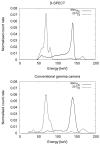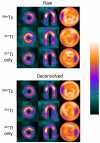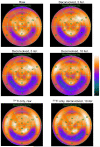Iterative deconvolution of simultaneous 99mTc and 201Tl projection data measured on a CdZnTe-based cardiac SPECT scanner
- PMID: 21317483
- PMCID: PMC3111906
- DOI: 10.1088/0031-9155/56/5/012
Iterative deconvolution of simultaneous 99mTc and 201Tl projection data measured on a CdZnTe-based cardiac SPECT scanner
Abstract
We present a method of correcting self-scatter and crosstalk effects in simultaneous technetium-99m/thallium-201 stress/rest myocardial perfusion (single photon emission computed tomography) SPECT scans. The method, which is in essence a hybrid between the triple energy window method and scatter modelling, is based on a model of spatial and spectral distribution of projection counts in several selected energy windows. The parameters of the model are determined from measurements of thin rod sources in air when no in-object scatter or attenuation effects are present. The model equations are solved using the iterative maximum likelihood expectation maximization algorithm in the projection space to find estimates of the primary photopeak counts of both radionuclides. The method has been developed particularly for a novel dedicated cardiac camera based on CdZnTe pixellated detectors, although it can also be adapted to a conventional scintillator camera. The method has been validated in anthropomorphic phantom experiments. Significant improvement in defect contrast has been observed with only moderate increase in image noise. The application of the method to patient data is illustrated.
Figures











References
-
- Beekman FJ, de Jong HW, van Geloven S. Efficient fully 3-D iterative SPECT reconstruction with Monte Carlo-based scatter compensation. IEEE Trans Med Imaging. 2002;21(8):867–877. - PubMed
-
- Berman DS, Kiat H, Van Train K, Friedman JD, Wang FP, Germano G. Dual-isotope myocardial perfusion spect with rest thallium-201 and stress tc-99m sestamibi. Cardiol Clin. 1994;12(2):261–270. - PubMed
-
- DePuey EG. Simultaneous thallium-201/technetium-99m dual-isotope cardiac SPECT: ready for prime time? J Nucl Med. 1993;34(11):2006–2008. - PubMed
-
- Erlandsson K, Kacperski K, van Gramberg D, Hutton BF. Performance evaluation of D-SPECT: a novel SPECT system for nuclear cardiology. Phys Med Biol. 2009;54(9):2635–2649. - PubMed
Publication types
MeSH terms
Substances
Grants and funding
LinkOut - more resources
Full Text Sources
Other Literature Sources
